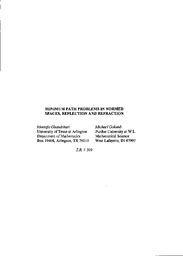| dc.contributor.author | Golomb, Michael | en |
| dc.contributor.author | Ghandehari, Mostafa | en |
| dc.date.accessioned | 2010-06-08T17:38:48Z | en |
| dc.date.available | 2010-06-08T17:38:48Z | en |
| dc.date.issued | 1996 | en |
| dc.identifier.uri | http://hdl.handle.net/10106/2393 | en |
| dc.description.abstract | **Please note that the full text is embargoed** ABSTRACT: The main minimum (or extremum) path problem in this paper deals with the "law of refraction" at a curve separating the plane into two parts with different norms. Analytic and geometric characterization for the point at which refraction takes place and formulas for the angles that this incident and refracted rays make with a fixed axis or with the normal to the curve are established. The case where the unit circle of the two norms are Euclidean circles with different radii leads to the traditional Snell's Law. The other problem deals with the "law of reflection" from a curve in the normed plane, which in the case of Euclidean norm asserts the equality of the angles of incidence and reflection. The 3-dimensional case, where the separating curve is replaced by a surface, is also considered. Finally it is shown that minimization of path length with respect to non-Euclidean norms is not a special case of Fermat's principle of minimizing the line integral [see pdf for notation] for a suitable refraction index n. | en |
| dc.language.iso | en_US | en |
| dc.publisher | University of Texas at Arlington | en |
| dc.relation.ispartofseries | Technical Report;309 | en |
| dc.subject | Fermat's principle | en |
| dc.subject | Snell's law | en |
| dc.subject | minimization of path length | en |
| dc.subject | Normed linear space | en |
| dc.subject.lcsh | Electromagnetic waves | en |
| dc.subject.lcsh | Mathematics Research | en |
| dc.title | Minimum Path Problems in Normed Spaces, Reflection and Refraction | en |
| dc.type | Technical Report | en |
| dc.publisher.department | Department of Mathematics | en |

